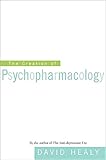The Creation of Psychopharmacology / David Healy.
Material type: TextPublisher: Cambridge, MA : Harvard University Press, [2009]Copyright date: ©2004Description: 1 online resource (480 p.)Content type:
TextPublisher: Cambridge, MA : Harvard University Press, [2009]Copyright date: ©2004Description: 1 online resource (480 p.)Content type: - 9780674038455
- 616.891809
- RM315 -- H434 2002eb
- online - DeGruyter
| Item type | Current library | Call number | URL | Status | Notes | Barcode | |
|---|---|---|---|---|---|---|---|
 eBook
eBook
|
Biblioteca "Angelicum" Pont. Univ. S.Tommaso d'Aquino Nuvola online | online - DeGruyter (Browse shelf(Opens below)) | Online access | Not for loan (Accesso limitato) | Accesso per gli utenti autorizzati / Access for authorized users | (dgr)9780674038455 |
Browsing Biblioteca "Angelicum" Pont. Univ. S.Tommaso d'Aquino shelves, Shelving location: Nuvola online Close shelf browser (Hides shelf browser)

|

|

|

|

|

|

|
||
| online - DeGruyter Out of the Woods : Tales of Resilient Teens / | online - DeGruyter Preface to Plato / | online - DeGruyter The Saint-Napoleon : Celebrations of Sovereignty in Nineteenth-Century France / | online - DeGruyter The Creation of Psychopharmacology / | online - DeGruyter Leadership Without Easy Answers / | online - DeGruyter The Puritans in America : A Narrative Anthology / / | online - DeGruyter Revolution on My Mind : Writing a Diary under Stalin / |
Frontmatter -- Contents -- Introduction -- 1 Strangers in a Strange Land -- 2 The Doctoring of Madness before Chlorpromazine -- 3 Explorations in a New World -- 4 Psychiatry outside the Walls -- 5 Twisted Thoughts and Twisted Molecules -- 6 Positive and Negative -- 7 The Sorcerer's Apprentice -- 8 Democracy -- Notes -- Acknowledgments -- Index
restricted access online access with authorization star
http://purl.org/coar/access_right/c_16ec
David Healy follows his widely praised study, The Antidepressant Era, with an even more ambitious and dramatic story: the discovery and development of antipsychotic medication. Healy argues that the discovery of chlorpromazine (more generally known as Thorazine) is as significant in the history of medicine as the discovery of penicillin, reminding readers of the worldwide prevalence of insanity within living memory. But Healy tells not of the triumph of science but of a stream of fruitful accidents, of technological discovery leading neuroscientific research, of fierce professional competition and the backlash of the antipsychiatry movement of the 1960s. A chemical treatment was developed for one purpose, and as long as some theoretical rationale could be found, doctors administered it to the insane patients in their care to see if it would help. Sometimes it did, dramatically. Why these treatments worked, Healy argues provocatively, was, and often still is, a mystery. Nonetheless, such discoveries made and unmade academic reputations and inspired intense politicking for the Nobel Prize. Once pharmaceutical companies recognized the commercial potential of antipsychotic medications, financial as well as clinical pressures drove the development of ever more aggressively marketed medications. With verve and immense learning, Healy tells a story with surprising implications in a book that will become the leading scholarly work on its compelling subject.
Mode of access: Internet via World Wide Web.
In English.
Description based on online resource; title from PDF title page (publisher's Web site, viewed 30. Aug 2021)


